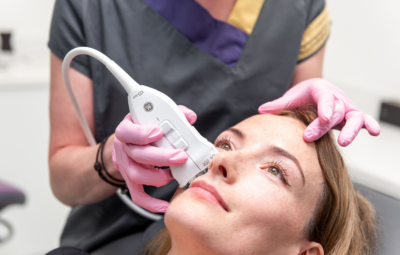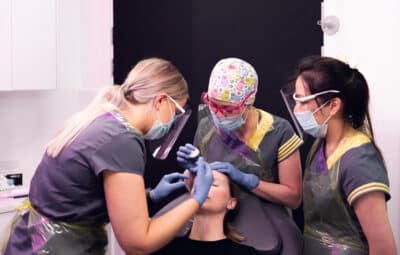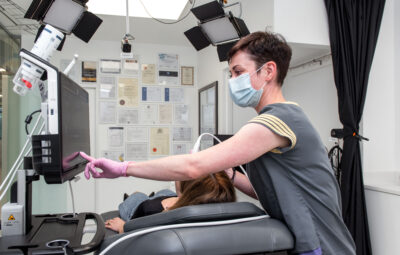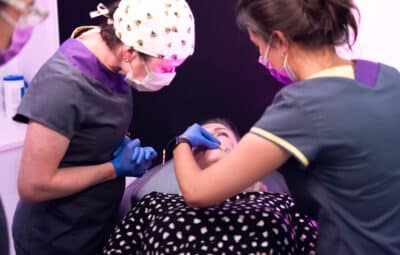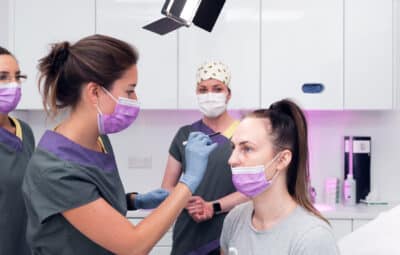
How to Fix Lip Filler Migration: A Practitioner's Guide
15 May 2025
In this post:
- Lip filler migration is a common, preventable complication where filler moves beyond the intended area, often due to overfilling, poor technique, or incorrect product choice.
- Prevention starts with thorough consultations, choosing the right product, and using correct technique. Gradual treatment plans and knowing when to stop are key. Facial ultrasound offers significant advantages for assessment and precision.
- Treatment involves patient education and dissolving migrated filler with hyaluronidase, followed by a 4–6 week waiting period before any re-treatment.
In the last couple of decades, lip filler treatments have surged in popularity. At our Liverpool-based aesthetic practice Smileworks, we see new patients every week seeking their dream lips. Lip filler is one of our most popular aesthetic treatments, and we’re seeing no sign of this popularity slowing down.
However, with this rise in demand comes an increased responsibility for injectors to understand and manage potential lip filler complications. In particular, lip filler migration remains one of the most common yet preventable complications that patients deal with.
This blog post aims to equip aesthetic practitioners with the clinical knowledge to understand, prevent, and effectively manage lip filler migration. Drawing from real clinical experience, we’ll explore the anatomical considerations, techniques, and evidence-based approaches that lead to results your patients will obsess over.
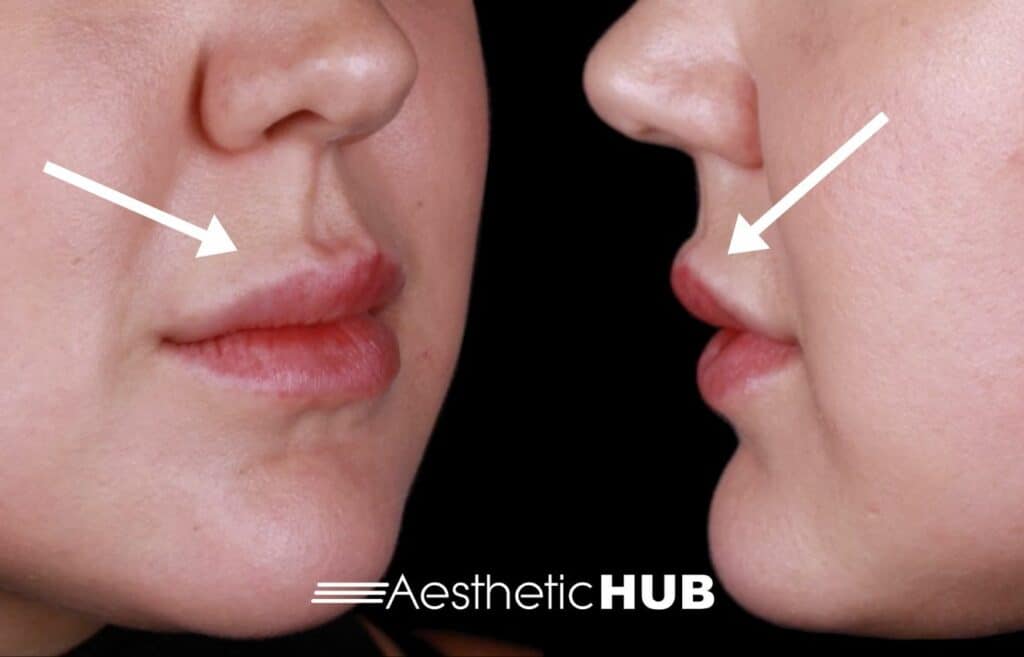
What is Lip Filler Migration?
Lip filler migration refers to the displacement of dermal filler product outside of the intended anatomical zone. It’s normal to experience some post-treatment swelling, but when this swelling does not go away, this is a sign of migrated filler. Migration can occur either straight after treatment or develop gradually over months or even years.
Spotting lip filler migration is relatively easy. If there is blurring or bulging of the vermillion border that causes the loss of the crisp white roll definition that frames the lips, chances are the patient is experiencing migration. A ‘filler moustache’ may also develop, causing an unnatural protrusion above the upper lip that becomes particularly noticeable during lip movement.
Lumps or nodules that persist beyond the normal healing period are also signs of migration. In some cases, perioral lines may show visible product that has traveled from the lip into the surrounding rhytids.
Many patients and less experienced injectors initially mistake migration for post-procedure swelling. Differentiating between the two is crucial. While swelling is typically symmetrical, diffuse, and shows gradual improvement over the course of a few days, migration presents with specific anatomical distortion that persists or worsens over time.
Why Does Lip Filler Migration Happen?
To understand what causes migration, we must look at lip filler technique and tissue interaction. From an injector’s point of view, there are several key factors that can cause this complication.
Overfilling
The lips have a finite capacity to accommodate filler. When this threshold is pushed to its limits, the product follows the path of least resistance. This is where we see superior migration. Building on old or poorly integrated filler creates pressure that forces new product beyond its intended boundaries.
Even technically perfect injections can lead to migration if total volume exceeds what the tissues can naturally contain.
Poor Injection Technique
Migration commonly occurs when product is injected too superficially into the mucosa rather than in the appropriate submucosa plane. Failure to maintain proper needle or cannula positioning throughout treatment also significantly increases risk.
Perioral injection errors, such as placing product too close to the vermillion border without respecting anatomical boundaries, are another frequent cause of visible migration.
Choosing The Wrong Filler Type
Using fillers with excessive firmness or lifting capacity (high G-prime products) in the delicate lip tissue can contribute to migration. Products that do not integrate well with the surrounding tissue due to lack of cohesivity are more prone to displacement. You wouldn’t use the same type of dermal filler in the lips as you would the lips.
Fillers that attract excessive water or have high projection properties may also contribute to migration as they interact with the tissue over time.
Anatomical Ignorance
Injecting into orbicularis oris muscle rather than the submucosa creates movement-related migration as the product is constantly disturbed during facial expressions.
Not accounting for how lip movement affects filler placement over time leads to predictable migration patterns. Attempts to create artificial shapes that work against the lips’ natural anatomical structure often result in product shifting in an attempt to get back to that natural structure.
Patient-Related Factors
Every patient responds to filler differently. Some exhibit stronger tissue reactions that contribute to filler migration. Variations in metabolism can lead to uneven product degradation across the treatment area.
Post-treatment behaviours can also play a role in how the lip filler settles. Excessive facial movement, pressure, or manipulation during the healing period may cause migration.
How to Prevent Lip Filler Migration
Preventing lip filler migration begins at the patient’s initial consultation. Every injector should adopt a comprehensive approach that prioritises assessment, proper technique, and knowing when enough filler is enough.
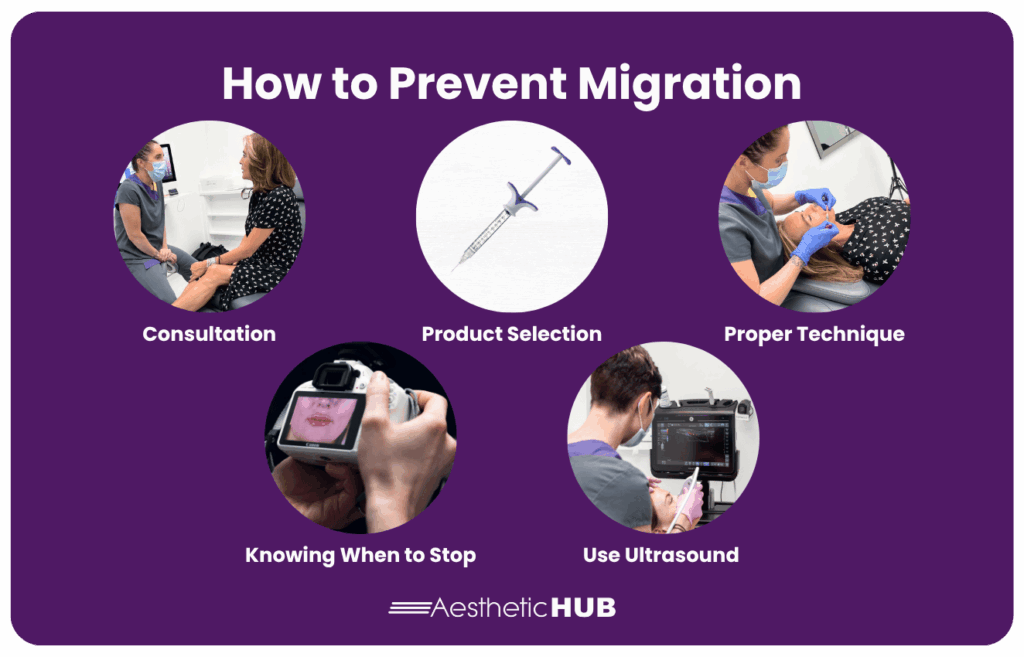
Consultation
A thorough consultation should document previous filler treatments including the product, placement, and timing. Setting clear expectations about what can be achieved safely within the patient’s unique anatomical limits is crucial.
At the consultation, be sure to evaluate any patient-specific factors that could increase migration risks. These include previous filler complications, facial habits, and tissue characteristics.
Product Selection
Choose low G-prime, cohesive hyaluronic acid dermal fillers specifically formulated for the delicate lip tissue. Keep in mind that different fillers suit defining borders versus adding volume. Use each appropriately based on the specific anatomical area being treated. Consider product integration properties carefully, as products that integrate will with tissue reduce migration risks.
Technique Matters
Micro-bolus or linear threading techniques, when executed properly, minimise tissue trauma and allow for controlled placement. Maintain consistent depth appropriate to the anatomical zone being treated throughout the procedure.
A minimal trauma approach reduces inflammation and lowers the risk of migration. Allow time between injections to assess the tissue accommodation rather than rushing to complete the treatment.
For more on our preferred technique, see our blog post on lip filler injection techniques.
Knowing When to Stop
In cases of lip filler gone wrong, it’s often because the injector didn’t know when to stop. It’s crucial to resist the pressure from your patient for an immediately volumised result.
For most, a gradual treatment approach with multiple sessions produces better outcomes than a single treatment with multiple millilitres of filler. Treatment completion should always be guided by anatomical harmony, not millilitre targets or patient demands for more volume.
Use Facial Ultrasound (If Trained)
For practitioners with appropriate facial ultrasound training, ultrasound offers unprecedented advantages. Pre-treatment assessment with ultrasound allows for visualisation of pre-existanting filler. This helps avoid laying new filler onto potentially problematic old filler.
During the actual procedure, ultrasound is also helpful for verifying that the filler is placed in the intended spot. This eliminates the risk of migration that comes with blind injecting.
How to Fix Lip Filler Migration
As we mentioned above, lip filler migration almost always presents as the loss of the crisp line between the lip and the skin. Protrusion or fullness above the anatomical lip border is also a sign.
If your patient has suspected lip filler migration, it’s important to treat it as soon as possible.
Educate & Reassure Your Patient
Help your patient understand what has happened and why through a clear explanation of the migration process. Lip filler migration is a legitimate aesthetic concern, but it usually poses no risk to their health.
Explain to them that filler migration is highly treatable with hyaluronidase, and this isn’t a complication they’ll have to deal with forever.
Dissolve with Hyaluronidase
Hyaluronidase, an enzyme that occurs naturally in our bodies, is used for nearly all cases of lip filler dissolving. For those with a known bee/wasp allergy or previous hyaluronidase reaction, skin testing is recommended 20 minutes before treatment.
The injection of hyaluronidase should focus on targeted dissolution of the filler with precise placement. Appropriate dosing is typically 30-50 units for mild migration. There may be the need for multiple sessions for complex cases.
Post-Dissolving Protocols
Allow 4-6 weeks before considering reinjection to ensure complete resolution of both the migrated product and the hyaluronidase. When re-introducing filler to the lips, a conservative approach is a must. Rebuild the volume slowly over time to prevent a recurrence of migration.
Using Ultrasound to Manage Lip Filler Migration
Ultrasound technology is an important tool in any modern aesthetic practice. This machine allows precise product identification by visualising the exact location and extent of migrated filler. It enables differential diagnosis between filler, vascular structures, and other tissue that might otherwise be confused with migration.
When lip filler dissolving is necessary, ultrasound provides guided dissolution by directing hyaluronidase precisely where needed. Post-treatment, it offers a way to instantly verify whether the dissolving was successful.
Facial ultrasound training is the single best investment any injector can make. It is an invaluable tool for both preventing and managing lip filler complications. We’ve seen countless times how facial ultrasound has elevated the practices of our delegates. There is no better place to learn and gain real-world experience with this tool than at the Smileworks Aesthetic Training HUB.
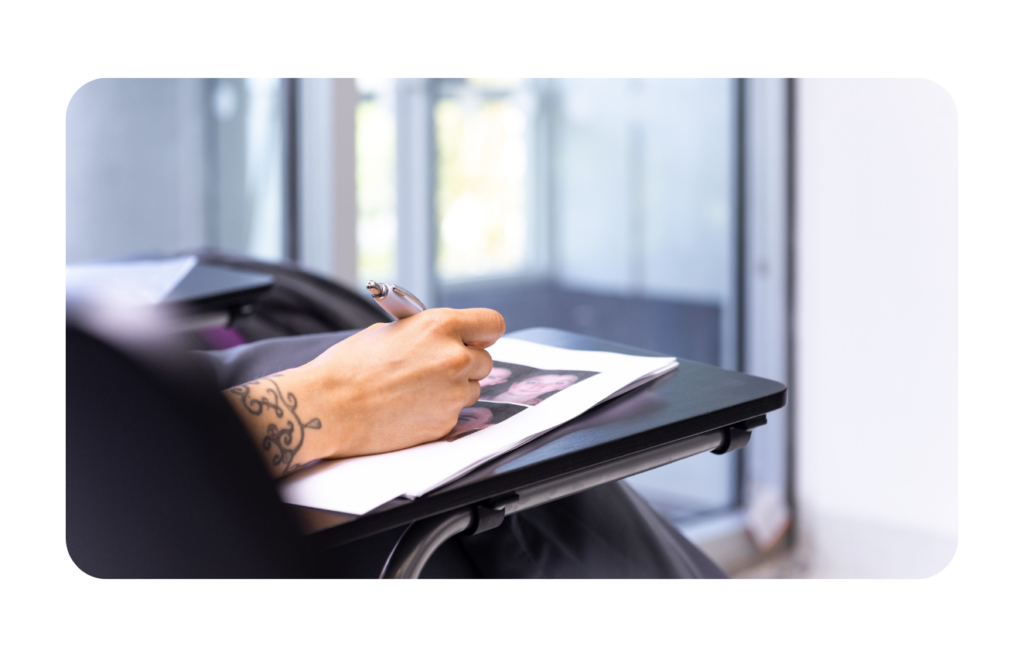
Learn How to Dissolve Lip Filler From The Best in the UK
It’s time to properly introduce ourselves. We are the Smileworks Aesthetic Training HUB – an esteemed aesthetic training centre based in the UK. We pride ourselves on our wide range of online and hands-on courses tailored for every skill level.
At the HUB, we offer the world’s most comprehensive lip filler complication training pathways in aesthetic ultrasound. Facial ultrasound is not just a tool for rare complication cases or advanced injectors. It’s the foundation for a safer, smarter, and more ethical practice.
For top-tier ultrasound learning, look no further than our Foundation Facial Ultrasound Course and our Advanced Facial Ultrasound Course, two musts for all injectors. Ultrasound is the single most important tool for ensuring safe and effective treatments every time.
For those looking for more in-depth training, we recommend booking a one-to-one mentoring session with Dr MJ. These sessions at 100% customisable, and you’ll receive personalised instruction based on your skill level and goals.
Join us at the HUB. Let’s shape the future of aesthetic medicine together and ensure safe, effective, and transformative results for every patient.
Want to try out our courses before committing? Take advantage of our free trial for a taste of what learning at the HUB is like.
Related blog posts:
